In 2014 and 2015, professional archaeologists conducted archaeological excavations along the Upper Ohio River in Beaver County.
Archaeologists investigated two deeply buried pre-contact Native American sites as part of a cultural resource management (CRM) project associated with a petrochemical plant project.
The two sites were registered with the PA SHPO and assigned site numbers 36BV0051 and 36BV0380.
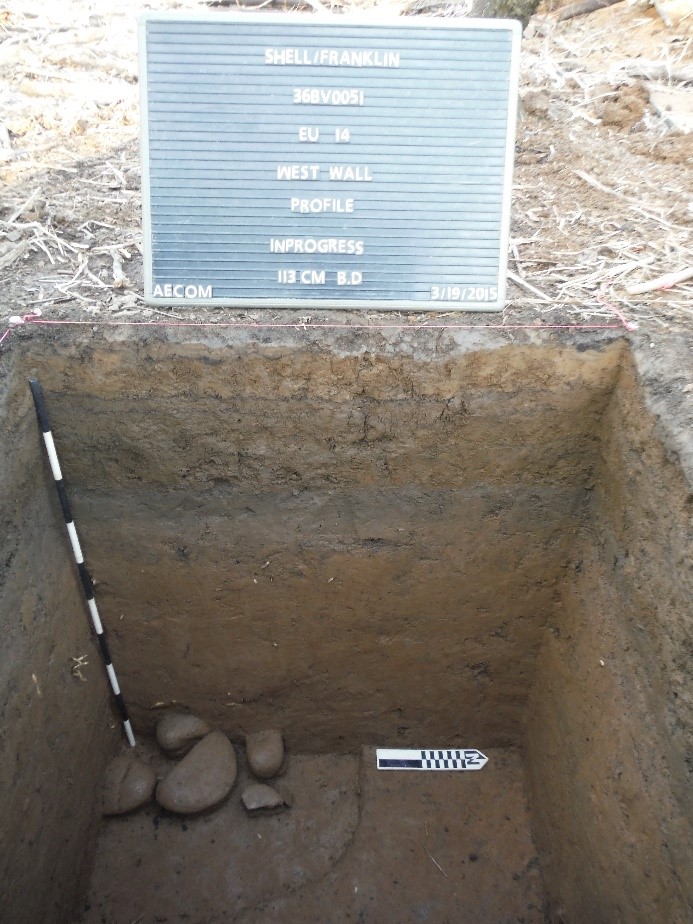
The two sites were situated on the Ohio River floodplain roughly 500 feet apart from each other and preserved beneath hundreds of years-worth of flood deposits.
Because the sites were so well preserved, investigators were able to collect important information about pre-contact life on the Ohio River.
Archaeologists recovered artifacts and documented archaeological features including hearths and storage pits more than 8 feet below the ground surface that provide information about changes in stone tool production and food preparation over thousands of years.
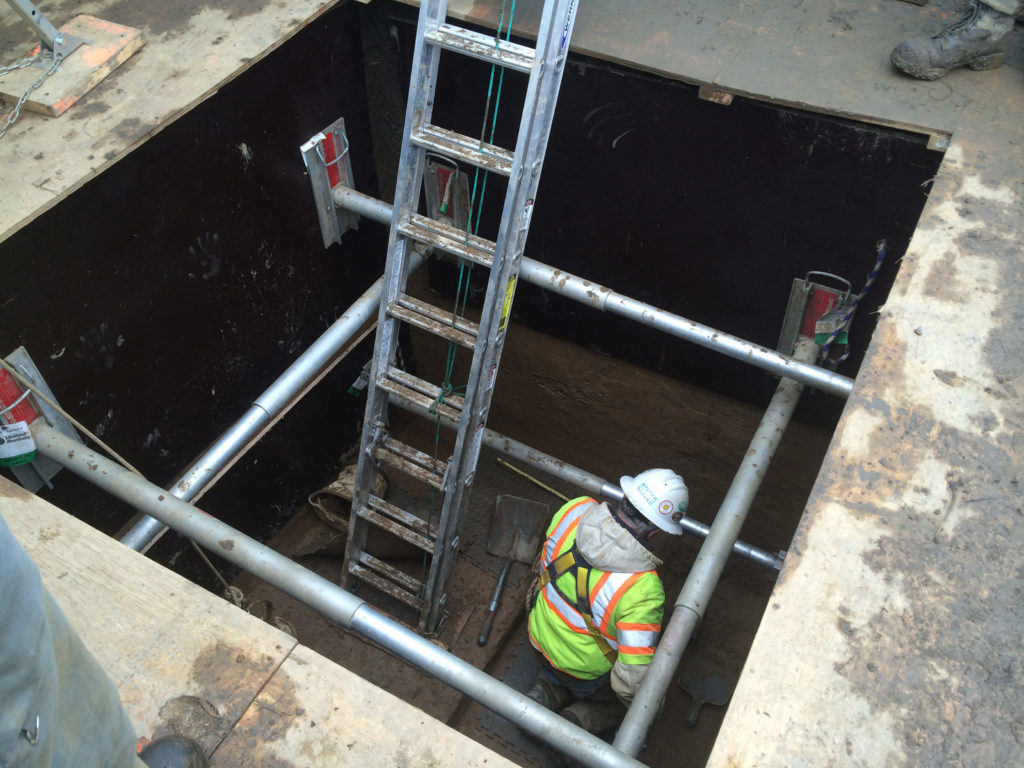
Paleobotanists analyzed the charred plant remains from the hearths and pits to determine changes in subsistence practices in the region. Geoarchaeologists collected data from soil cores across the floodplain and were able to determine the age of the landforms and characterize changes in the environment.
Dating the Sites
Sites 36BV0051 and 36BV0380 contain archaeological remains found at different depths below the ground surface, which date to more than one archaeological time period.
The archaeologists were able to get radiocarbon dates from organic remains they recovered from hearths and pits (features) at various depths.
Charcoal from hearths found at 36BV0051 indicate that the earliest occupations at the site date to 8,000 years ago and was last occupied during a period between 5,600 to 5,400 years ago.
At 36BV0380, features dated from 2,925 years ago to 760 years ago. Relative dates from the projectile point and ceramics types correlate with the radiocarbon dates from the features.
Artifact Discoveries
Compared to other investigations in the region, the excavations at 36BV0051 and 36BV0380 were limited, so the number of artifacts recovered are relatively low.
In total, only around 2,500 pre-contact artifacts were collected at 36BV0051 and 36BV0380. In comparison, approximately 100,000 precontact artifacts were found at 36AL0480, which is also located on the Ohio River floodplain and only 13 miles upstream from 36BV0051 and 36BV0380.
In addition to recently excavated artifacts from 36BV0051, the Carnegie Museum of Natural History has a small collection of 20 pre-contact artifacts that were previously collected from this site.
The collections from 36BV0051 and 36BV0380 include three main artifact class types: stone artifacts, ceramics, and organic materials.
Stone artifacts
Stone artifacts include projectile points and other stone tools known as unifaces, scrapers, bifaces, net sinkers, utilized flakes, and cores, as well as the chipped stone debris that is the byproduct of producing stone tools.
Archaeologists broadly refer to these artifacts as ‘lithics’ and lithics comprise 92% of all artifacts recovered from the sites. Projectile points recovered from the sites include style types known as Lamoka, Jacks Reef Corner Notched, and Steubenville Stemmed.
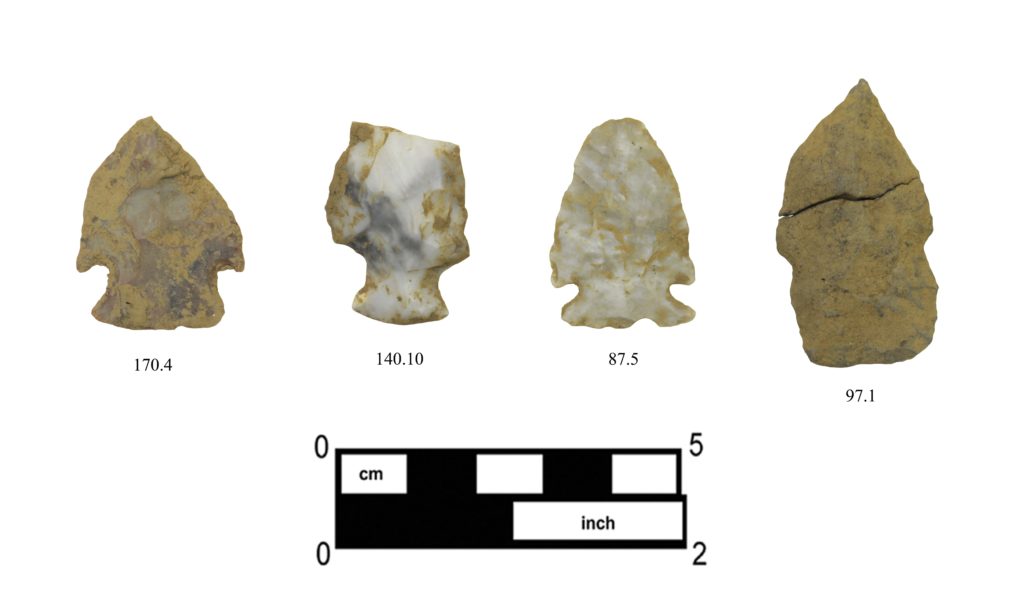
The Lamoka and Steubenville Stemmed projectile points date from 6,000 to 3,000 years ago, which is a time frame that archaeologists refer to as the Late Archaic Period. The Jacks Reef Corner Notched projectile points date from 1,500 to 1,100 years ago, which is an age that archaeologists refer to as the Middle Woodland Period.
Other stone artifacts recovered from the sites include nutting stones which were used to process walnuts. The consumption of walnuts was a common Native American subsistence practice. Archaeologists also recovered fire-altered cobbles from the hearths which provides evidence of cooking and roasting activities.
Ceramics
The ceramic fragments from clay pipes found at the sites represent a technology that first appears in the archaeological record about 2700 years ago.
The ceramic sherds recovered from the sites are generally smaller than 2 centimeters in size and can be difficult to categorize. However, several larger pottery fragments were identified as Half Moon ceramics, and variants of the Half Moon type date to about 2700 years ago during a period archaeologist refer to as the Early Woodland Period (3,000 to 1,800 years ago).
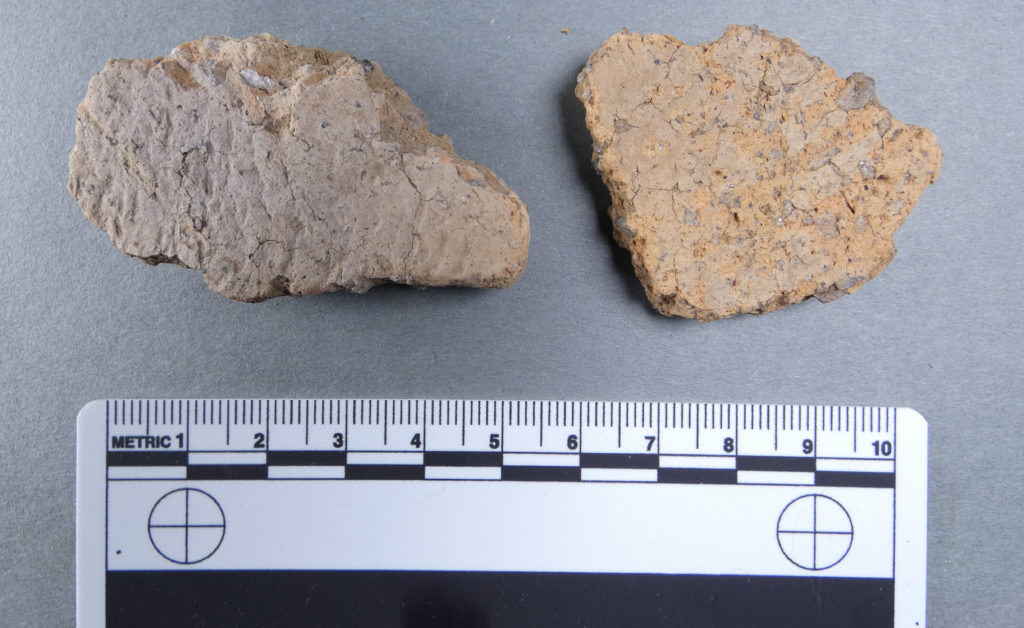
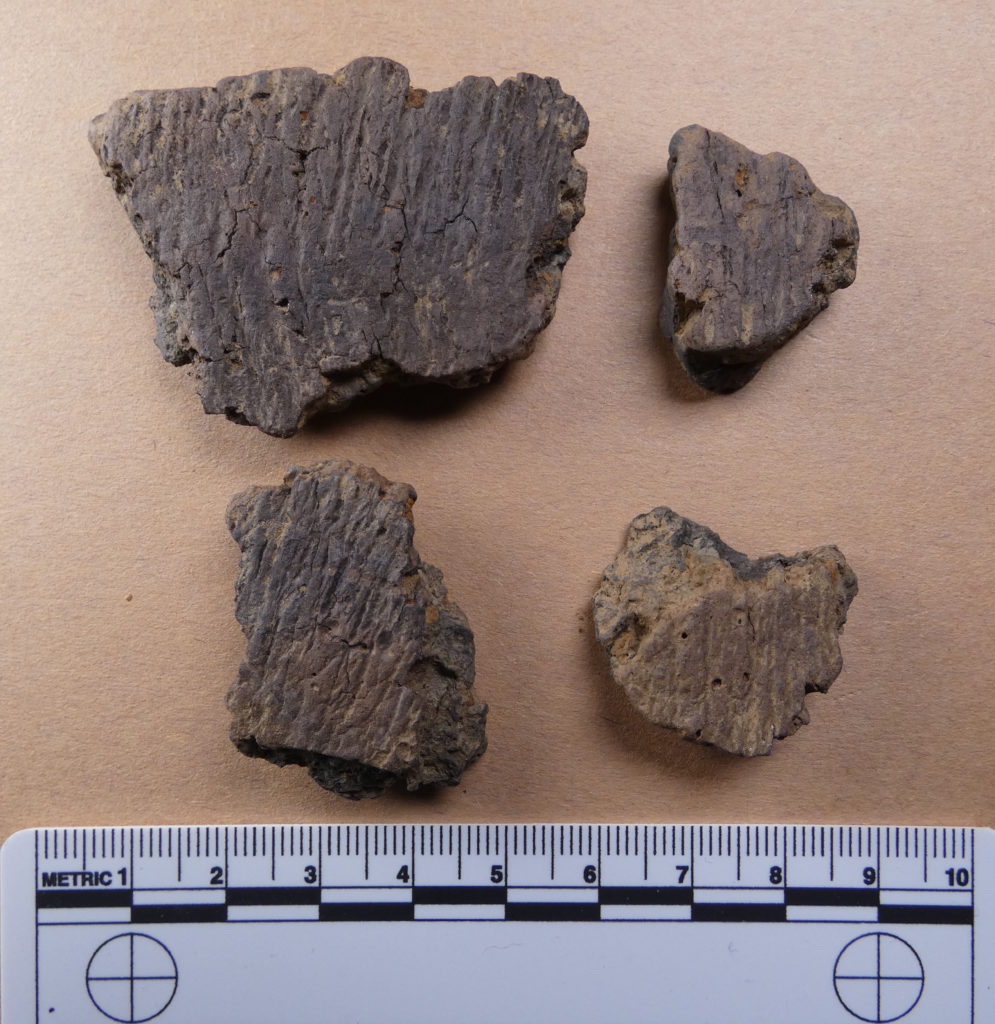
Evidence suggests that Half Moon pottery were thick-walled and flat-bottomed vessels developed in the Upper Ohio drainage basin.
Organic Materials
Charred plant remains recovered from the sites include walnut nutshell and wood charcoal samples of hickory, American beech, yellow poplar, elm, black locust, ash, and maple/birch. These artifacts provide archaeologists with insight into both subsistence activities as well as environmental data.
Archaeologists also recovered a hematite hemisphere from an excavation unit at 36BV0380.
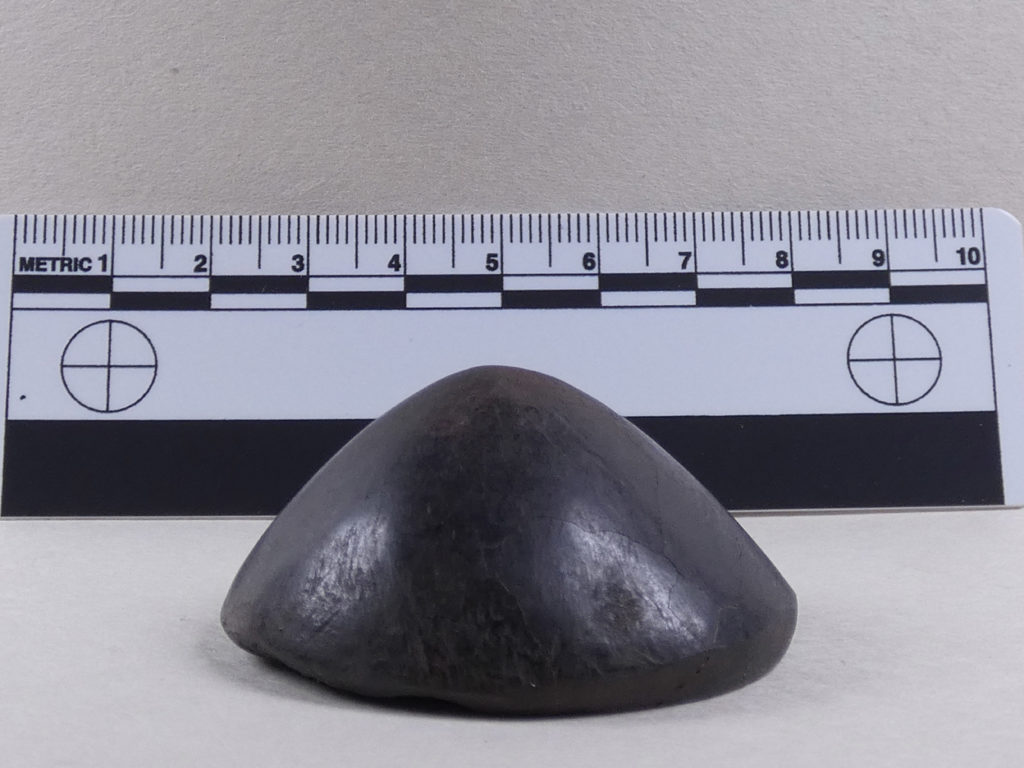
The hemisphere is a cone-shaped polished stone typically found in association with burial features dating from approximately 2,400 years ago to 1,850 years ago. and associated with the Adena Complex. No Native American burials were found at 36BV0051 or 36BV0380.
Hemispheres and cones of similar shape have been found at Adena sites such as the Natrium Mound and Cresap Mound in West Virginia. Hemispheres and cones have also been recovered in Ohio and West Virginia but are uncommon in western Pennsylvania.
The Adena is not a single culture or group of people, but a ceremonial and trading system that extended from the upper Mississippi River Valley to Western New York and the Atlantic Coast. This artifact in addition to the Half Moon ceramics recovered at the sites indicate that the people who lived there utilized locally developed technologies and were a part of the larger Adena Interaction Sphere.
Impressions
This project provided a glimpse into Native American culture and daily life over the last 8,000 years along the Ohio River.
Excavations revealed that 36BV0051 and 36BV0380 were likely camp sites, but due to the limited amount of excavation, it was not possible to determine if they represented larger long-term camps or smaller, seasonal camps. The soils and past environments they represent are similar to those encountered at other sites in the region.
Large artifact-rich pre-contact sites are commonplace along the Upper Ohio River in Pennsylvania, West Virginia, and Ohio, although there is relatively little understood about these sites in Pennsylvania.
Further analysis of the collections and comparative studies with other sites in the Upper Ohio River Valley and beyond can help provide insights into regional adaptations and larger cultural interactions. An article presenting the results of the project and further analysis will also be published in the Pennsylvania Archaeologist.
Today’s Guest Contributor is Jesse Walker, RPA, Associate Vice President of AECOM’s Cultural Resource Department, East.
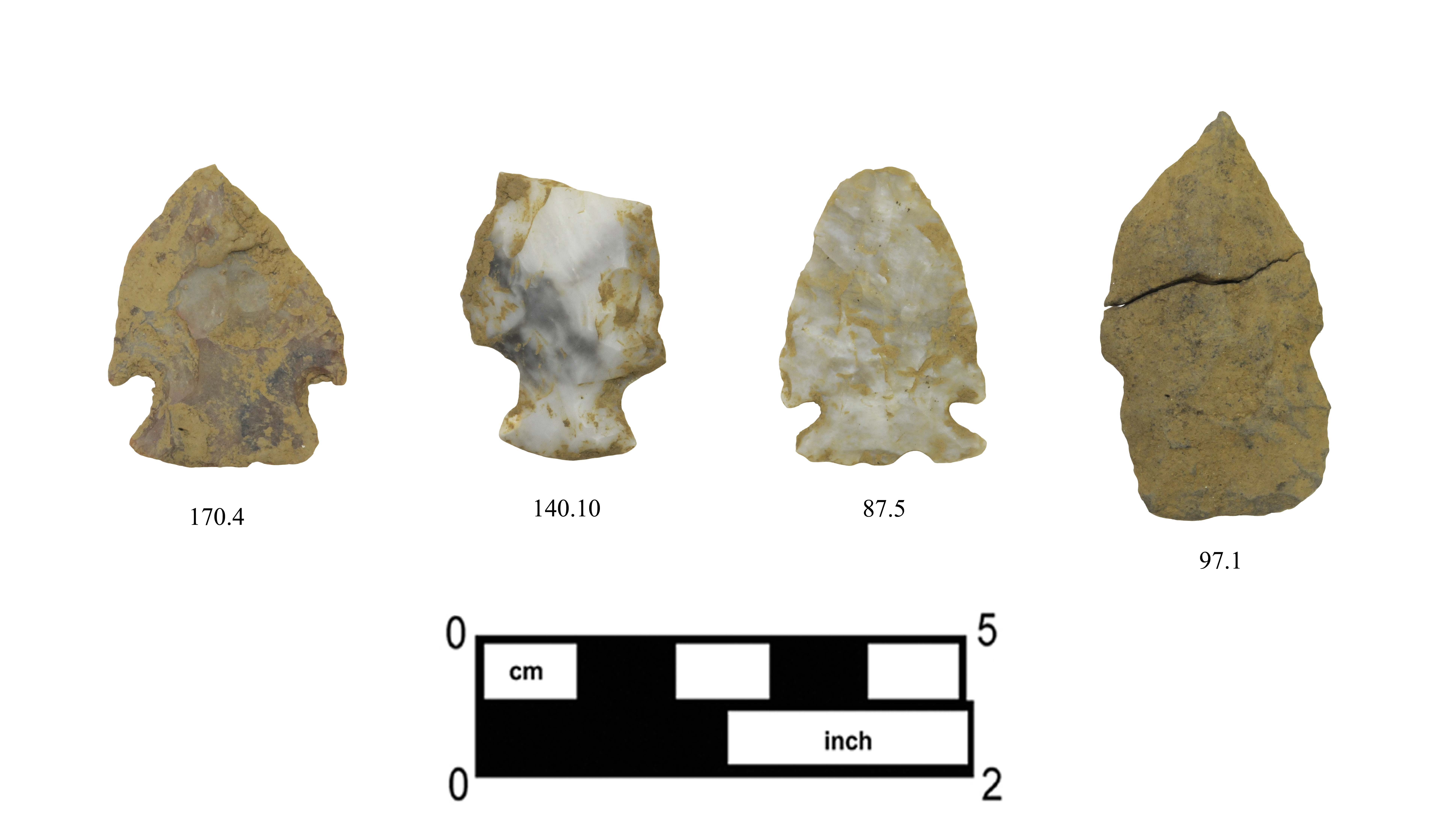
Leave a Reply